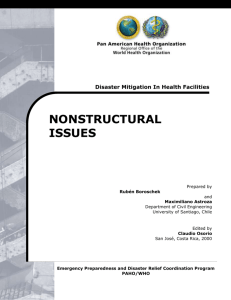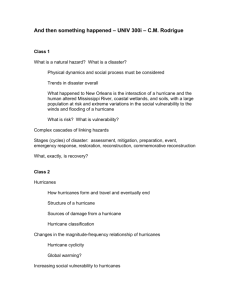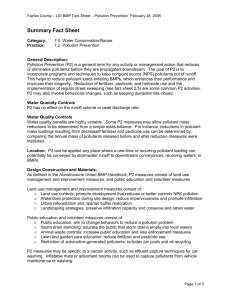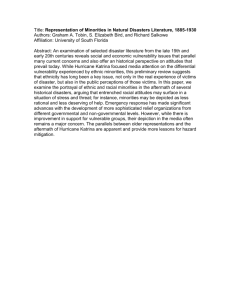Nonstructural Elements - DISASTER info DESASTRES
advertisement
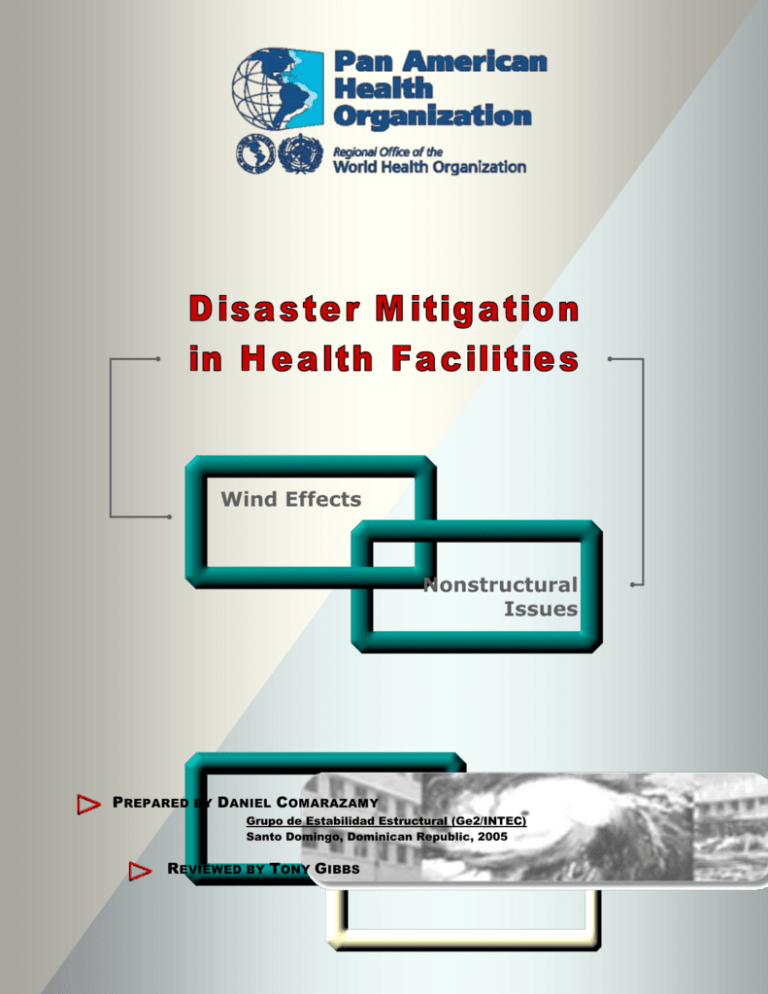
Wind Effects Nonstructural Issues PREPARED BY D ANIEL COMARAZAMY Grupo de Estabilidad Estructural (Ge2/INTEC) Santo Domingo, Dominican Republic, 2005 REVIEWED BY TONY GIBBS Pan American Health Organization Santo Domingo, Dominican Republic, 2004 A publication of the Area on Emergency Preparedness and Disaster Relief, PAHO/WHO. Pan American Health Organization, 2005 A publication of the Area on Emergency Preparedness and Disaster Relief, PAHO/WHO. The views expressed, the recommendations formulated, and the designations employed in this publication do not necessarily reflect the current policies or opinions of the Pan American Health Organization or of its Member States The Pan American Health Organization welcomes requests for permission to reproduce or translate, in part or in full, this publication. Applications and inquiries should be addressed to the Area on Emergency Preparedness and Disaster Relief, Pan American Health Organization, 525 Twenty-third Street, N.W., Washington, D.C. 20037, USA; fax: (202) 775-4578; e-mail: disaster-publications@paho.org. The production of this publication was made possible thanks to the financial support of the Disaster Preparedness Program of the European Commission Humanitarian Aid Office (DIPECHO-III). In addition, the following agencies provided assistance for the production and development of this material: the Division of Humanitarian Assistance, Peace and Security of the Canadian International Development Agency (HAPS/CIDA), the Office of Foreign Disaster Assistance of the U.S. Agency for International Development (OFDA/USAID), and the Department for International Development (DFID) of the United Kingdom. The production of this publication has been made possible through the financial support of the Disaster Preparedness Program of Humanitarian Aid Office ECHO (DIPECHO-III) TABLE OF CONTENTS OBJECTIVES ............................................................................................................................. 4 INTRODUCTION ...................................................................................................................... 4 HOSPITAL VULNERABILITY ASSESSMENT ................................................................ 5 Previous experience ............................................................................................................. 6 Visual inspection.................................................................................................................... 6 Collection of information .................................................................................................... 6 Nondestructive tests ............................................................................................................ 6 Mathematical modeling....................................................................................................... 6 Structural analysis and design ........................................................................................ 6 Wind-tunnel tests.................................................................................................................. 6 Retrofitting recommendations ......................................................................................... 6 ARCHITECTURAL ELEMENTS ............................................................................................ 7 INTERACTION OF THE STRUCTURE WITH NONSTRUCTURAL ELEMENTS ..... 8 REDUCING THE VULNERABILITY OF OPENINGS .................................................... 8 EQUIPMENTAND BASIC INSTALLATIONS .................................................................. 9 SPECIAL REINFORCEMENTS ............................................................................................ 10 WINDBORNE DEBRIS ......................................................................................................... 10 Pan American Health Organization PAHO/WHO Disaster Mitigation in Health Facilities OBJECTIVES The main objective of this document is to introduce technicians, administrators, doctors, and other stakeholders—who are not necessarily specialists in risk management of health facilities in Latin America and the Caribbean—to the effects of hurricanes on the secondary or nonstructural elements of those facilities. The topics addressed include disaster preparedness and identification, assessment, and mitigation of hazards posed by hurricanes to nonstructural elements in hospitals and other health facilities. Although non-specialists can engage in basic vulnerability assessments and identification of suitable mitigation measures, some aspects do require the intervention of experts. For example, the services of a wind engineer would be necessary to determine wind loads affecting connections that secure architectural components to the façade of a building. Applying even the most basic damage mitigation principles can significantly reduce the risk faced by health facilities in the event of a hurricane. These events are accompanied by torrential rain that can cause floods and landslides. Storm surges may damage structures built near the coast. Extreme wind gusts, however, are what characterize hurricanes and are the direct or indirect cause of most of the damage. This manual, accordingly, will focus on the vulnerability of the nonstructural elements of health facilities to the impact of extreme winds. INTRODUCTION To ensure that health facilities can continue to function after a hurricane, reducing their vulnerability to strong winds cannot be restricted to limiting structural damage. Health facilities are complex systems consisting of structural, nonstructural and functional elements that must interact smoothly to meet the institution’s objectives. Clinical and support services function thanks to the interaction of their human and physical components. Assessing the risks to these components and their interactions is the only way to ensure the adoption of effective mitigation measures that can guarantee the continuity of a hospital’s critical operations during a severe hurricane. Vulnerability reduction with respect to hurricanes needs to be both physical and organizational. The vulnerability of physical components of a hospital can be categorized into structural and nonstructural elements. Structural elements allow the building to continue standing; they include foundations, columns, beams, load-bearing walls, and slabs. Their main function is to absorb and transmit the various loads (which include the building itself, or “dead load”, as well as seismic loads, wind loads, and others) to the foundations, where the soil will assimilate and effectively neutralize the loads. Nonstructural elements are those that receive the loads directly and transmit them to the structural elements. Examples include partition walls, external claddings, roofing, windows, and doors, and elements that have special functions such as communication networks, gas and water piping, electrical wiring, and medical and support equipment and supplies. Wind Effects – Nonstructural Issues 4 Pan American Health Organization PAHO/WHO Disaster Mitigation in Health Facilities A crucial relation exists between the structural and nonstructural elements of a building. For example, architectural façades can substantially modify the expected performance of a building’s structural system. HOSPITAL VULNERABILITY ASSESSMENT Detecting the vulnerability of a health facility to wind-related hazards, and adopting at least some of the measures needed to mitigate the effects of hurricanes, sometimes require no other tools than a sharp eye and common sense. At other times, it is preferable that an architect or engineer carry out or supervise the vulnerability assessment of the structure and choose the best mitigation measures. Among the nonstructural elements that require the intervention of a trained professional are the façades, windows, roof coverings, external mechanical equipment, and storage tanks. Vulnerability assessment of nonstructural elements must take into account the fact that these elements are often interdependent. To strengthen this awareness, it is helpful to group nonstructural elements into three categories: (1) architectural elements, (2) equipment, and (3) basic mechanical and electrical systems (Slide No. 2). Table 1 lists elements belonging to each of these categories that hospitals commonly feature or house. Table 1 – Examples of nonstructural elements found in hospitals ARCHITECTURAL EXTERIOR EQUIPMENT BASIC INSTALLATIONS Façades Medical equipment Medical and industrial gases Roof coverings Industrial equipment Air conditioning Windows and glass Supplies Water tanks Exterior doors Office equipment Electrical generators Signage and antennae Hydraulic networks Pipes Nonstructural vulnerability assessments must involve both qualitative and quantitative analyses in order to judge the individual safety of each of these elements, the likely effect of their failure on the hospital’s operations, and the overall vulnerability of the hospital or health center. The interaction of structural and nonstructural elements when subjected to wind loads must be an ongoing concern. Wind Effects – Nonstructural Issues 5 Pan American Health Organization PAHO/WHO Disaster Mitigation in Health Facilities The following are some of the procedures or criteria for assessing the vulnerability of nonstructural elements to extreme winds (Slide No. 3): Previous experience: Previous experience with similar nonstructural elements in earlier hurricanes can serve as a preliminary indicator of vulnerability. However, it is also important to take into account the construction methods, materials used, and availability of local labor, as well as the local topographic conditions. Visual inspection: The periodic inspection of the condition of each nonstructural element plays a key role in preventing its failure during a hurricane. The element’s location and fastenings are of special importance, since deficiencies in this area can cause severe damage to the health facility, not to mention the potential impact on patients. Collection of information: It is important to verify that nonstructural elements have been correctly placed by comparing their actual location to that indicated in the as-built plans of the existing elements. If the plans are not available, an inventory must be carried out of the entire nonstructural infrastructure in the facility. This information should be digitalized for each facility so that it can be readily available whenever needed. Nondestructive tests: Experimental analysis through nondestructive testing is an important step in vulnerability assessments, since it shows the location and size of the various reinforcements, as well as the resistance of the various construction materials employed, without weakening the facility’s elements or interrupting the everyday operations of the hospital or health center. Mathematical modeling: Computer simulations rely on mathematical models that incorporate information on the mechanical, physical, and chemical characteristics of the various nonstructural elements in order to assess their vulnerability to hurricanes or other hazards. Structural analysis and design: Because the trend for wind-load standards is to follow the ASCE-7 standard, this document takes this approach into consideration (Slide No. 4). Analysis of nonstructural elements must take into account the design wind force, determined among other factors by the area of influence and the force coefficients that affect each nonstructural element (Slide No. 5). Wind-tunnel tests: Wind-tunnel testing is required when structural conditions become so complex that mathematical modeling alone cannot do the job. These tests make it possible to analyze the behavior of the elements when subjected to strong wind pressures, simulating the actual wind conditions of the site. Retrofitting recommendations: The repair of nonstructural elements damaged during a hurricane must be a priority, particularly in the case of hospitals, whose specialized departments and services should remain operational in order to meet the increased demand for health care after a hurricane. The reinforcement of nonstructural elements can significantly reduce hurricane-related risks for the facility and its occupants. Wind Effects – Nonstructural Issues 6 Pan American Health Organization PAHO/WHO Disaster Mitigation in Health Facilities Classifying hospital equipment is of enormous importance when carrying out vulnerability assessment and designing a mitigation plan (Slide No. 6). Table 2. Equipment Classification CATEGORY DESCRIPTION Indispensable Equipment that is essential for the functioning of health care services and cannot be replaced easily or inexpensively Essential Like the preceding, except that it can be replaced easily or inexpensively Dangerous Equipment that can injure people and damage objects Chaotic Equipment whose failure or damage may cause confusion Functional Equipment that is not needed to respond to a medical emergency ARCHITECTURAL ELEMENTS Architectural elements must be assessed in terms of the functional and physical consequences of their failure. Typical causes of failure involve the connections between elements, their distance to other elements, the element’s own fragility, and, of course, the demand placed on them by their location in the facility. When it comes to roofs, the type most readily resistant to extreme winds is the hipped roof (Slide No. 7), followed by gabled roofs (Slide No. 8) assuming that the slope remains at an angle of 20 to 30 degrees. The connection between the roofing and the structural elements calls for the correct design of the overall system, and the correct determination of size of the screws that are to be used (Slide No. 9). Similarly, the correct anchoring of metal roofing directly attached to masonry walls (Slide No. 10) by means of bolts or bars with the right development length is of critical importance. The same is true if the roofing system rests on roof frames or reticulated frames, particularly those located at the ends of the roof. INTERACTION OF THE STRUCTURE WITH NONSTRUCTURAL ELEMENTS During both the design and the construction stages, the independence of nonstructural elements must remain a key concern, since it can be assumed that they have not been designed to withstand the pressures generated by a hurricane. Wind Effects – Nonstructural Issues 7 Pan American Health Organization PAHO/WHO Disaster Mitigation in Health Facilities When the construction methods employed are inappropriate, nonstructural elements will end up working as part of the wind-resistant system, and may fail (Slide No. 11). An example of nonstructural elements where this can happen are masonry walls built between structural frames without properly separating the elements, turning the walls into part of the structural system and subjecting them to severe deformations or sudden failure. REDUCING THE VULNERABILITY OF OPENINGS Some nonstructural elements, such as exterior doors or windows, must be designed to protect the hospital not only from the direct impact of high winds, but also from the risk of windborne objects (missiles) which could penetrate the building envelope (i.e., walls, roofs, and foundations), and flooding of the interior of the facility by the rainfall associated with hurricanes. The use of metal folding blinds is advisable for covering large open spaces, as was done in the case of the Sint Maarten Medical Centre (Slide No. 12). The system provides adequate protection and is both functional and aesthetically pleasing (Slide No. 13). Anchoring such a protection system must strictly follow the manufacturer’s recommendations and should be done so that the system is anchored to both the exterior walls (Slide No. 14) and the interior columns (Slide No. 15), ensuring at least a minimum of protection against the design hurricane. Entry doors must be secured in such a way that internal pressures do not cause adverse conditions that may lead to failure. Special bolts must enable the effective securing of the doors during a hurricane (Slide No. 16). Experience of the action of hurricanes on hospital systems reveals that the greater the percentage of the building’s envelope that is made up of openings, the greater the impact of extreme winds on certain nonstructural elements, particularly windows (Slide No. 17). For instance, windborne missiles can breach the windows and cause severe injury to occupants and extensive damage to equipment (Slide No. 18). This accounts for the need to design a protection system against the infiltration of water and damage caused by windborne debris (Slide No. 19). Various protection systems for windows are used depending on the location of the health facility, taking into account such factors as terrain roughness or elevation exposure (Slide No. 20). This type of protection system, commonly referred to as hurricane shutters, has different designs. They can be: о о о Permanent systems (Slide No. 21) Roll-up systems (Slide No. 22) The use of plywood panels as long as appropriate mechanical or chemical anchoring is used. Wind Effects – Nonstructural Issues 8 Pan American Health Organization PAHO/WHO Disaster Mitigation in Health Facilities EQUIPMENT AND BASIC INSTALLATIONS Hospital equipment is essential for the facility’s correct functioning. It includes medical, laboratory, industrial, and office equipment, as well as furnishings and supplies. Since all this equipment is inside the hospital, it should theoretically not be exposed to strong winds or rain—so long as the building’s envelope is not breached. It is the job of the external nonstructural elements—the building’s exterior walls, windows, entry doors, and roof covering—to withstand the high wind pressures and the impact of falling objects or windborne missiles during the hurricane. The architectural elements within the hospital will not be exposed to wind loads unless the windows, entry doors, walls, or roof fail. It is therefore the architectural elements on the exterior of the building that need the greatest attention when it comes to assessing their vulnerability to extreme winds. Unlike equipment and accessories, some basic mechanical and electrical systems are installed externally, such as air conditioners, water-storage tanks, industrial gas tanks or emergency power generators. These basic systems are much more vulnerable to the action of the wind than interior equipment, so appropriate anchoring and protection are needed. Other basic nonstructural systems must be protected from the battering of the wind. An example is solar panels (Slide No. 23): their location and form of fastening must be chosen carefully. The same is true of air conditioning units, which should be fastened securely by using sleeves (Slide No. 24) and metal straps (Slide No. 25) to make sure they remain in place during the adverse event. The following are some of the measures that can be taken to protect architectural elements: 1. Using laminated glass. It protects occupants and assets better than other glass products. If the glass breaks, the fragments adhere to the plastic interlayer, reducing the risk of injuries and damage to property. 2. Installing additional storm protection equipment to cover exterior windows and doors during hurricanes and deflect the impact of windborne objects. 3. Using high-resistance bolts to secure the doors and windows. 4. Choosing materials that can withstand the wind loads. For instance, using tiles as a roof covering should be avoided. In hospital systems, great attention must be paid to the use and storage of oxygen, clinical gases, and industrial gases. Tanks located at the exterior walls of the hospital should be properly fastened so they cannot break loose in spite of the strong winds (Slide No 26). Resistant anchoring is a necessity to prevent damage to other equipment or serious injuries to patients and staff (Slide No 27). This is also true of gas storage tanks or drinking water tanks (Slide No 28). Wind Effects – Nonstructural Issues 9 Pan American Health Organization PAHO/WHO Disaster Mitigation in Health Facilities SPECIAL REINFORCEMENTS When considering special reinforcement for wood and metal structural elements, priority should be given to fastenings. Inadequate fastening of metal sheet roofing can cause damage to the building and also can damage unreinforced masonry walls (Slide No. 29). When employing metallic roofing, it is essential that it be properly attached to the rest of the structure, since this type of roof is easily torn off in a hurricane because of internal pressure, leaving the interior of the health facility exposed (Slide No. 30). Exterior elements of the windward structures, such as cladding or components, may become detached due to the extreme winds and, hurled through the air, turn into missiles that can cause serious damage and affect the structural integrity of the other buildings. When Hurricane Georges hit the Caribbean in 1998, a building in San Juan, Puerto Rico, was damaged by the impact of the detached roof-waterproofing system from another building across the street. Fortunately, only the cladding of the affected building suffered damage (Slide No. 31). WINDBORNE DEBRIS One of the most damaging effects of hurricanes is when items that are indequately fastened become detached and propelled, like missiles, by the wind. Metal sheets can cause severe damage to other buildings (Slide No. 32) and pieces of wood can damage the walls of a hospital (Slide No. 33) or even penetrate glass or wooden panels (Slide No. 34). Windborne debris can include water tanks that come off of another building and can injure persons and damage major structural systems, resulting in the collapse or interruption of hospital services (Slide No. 35). Wind Effects – Nonstructural Issues 10 Pan American Health Organization PAHO/WHO Disaster Mitigation in Health Facilities SLIDE AND IMAGE CREDITS D. Comarazamy—Text and slides T. Gibbs—Text review and photos C. Compañy— Photos A. Comarazamy—CAD drawings F. Sanchez—Graphic design and editing Pan American Health Organization (PAHO) Prepared by the: Grupo de Estabilidad Estructural (Ge2) / INTEC Ave Los Próceres, Galá Apdo 349-2 Santo Domingo, Dominican Republic www.intec.edu.do Wind Effects – Nonstructural Issues 11
